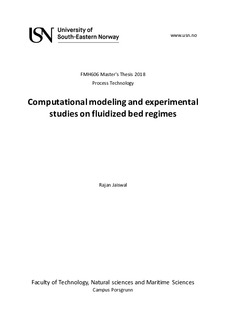| dc.description.abstract | The fluidization technology has a wide range of applications from chemical synthesis to pneumatic transportation and circulation of species. Different process applications require different flow regimes and the type of flow regimes depends on superficial gas velocity, particle size distribution, particle density and reactor dimensions.
This study investigates the influence of initial bed height, particle density and particle size distribution on the fluidized bed regime transition. Experiments are performed on a cold bed with sand, limestone and glass beads particles as bed materials. A Computational Particle Fluid Dynamic (CPFD) model is established using Wen- Yu and Ergun drag model in a simulation software Barracuda VR and further the CPFD model is validated using experimental results. The results from the simulations are compared with the experimental data and correlations in the literature. The onset of each regime i.e. minimum fluidization, bubbling, slugging and turbulent regime is identified using statistical analysis techniques. The statistical analysis methods include standard deviation of pressure fluctuation along the height of the bed and the change in solid volume fraction in the bed as a function of gas velocity.
The results show that the minimum fluidization velocity for sand (𝑑�𝑚� = 234𝜇�𝑚�) and limestone remain constant with change in the aspect ratio while it decreases to a stable value below aspect ratio of 1.5 for sand particle with mean diameter (𝑑�𝑚� = 346𝜇�𝑚�). Similarly, the minimum bubbling velocity for all the three types of particles are found to be independent of the static bed height. The onset of slugging velocity decreases with increase in the bed height for all the three particle types. The turbulent velocity for sand particles (𝑑�𝑚� = 234𝜇�𝑚�) increases slightly with increase in aspect ratio while it almost remains constant for sand (𝑑�𝑚� = 346𝜇�𝑚�) and limestone. With the increase in particle size distribution for limestone, 400𝜇�𝑚� − 1400𝜇�𝑚�, there is significant increment in minimum fluidization, bubbling, slugging and turbulent velocity. | nb_NO |
